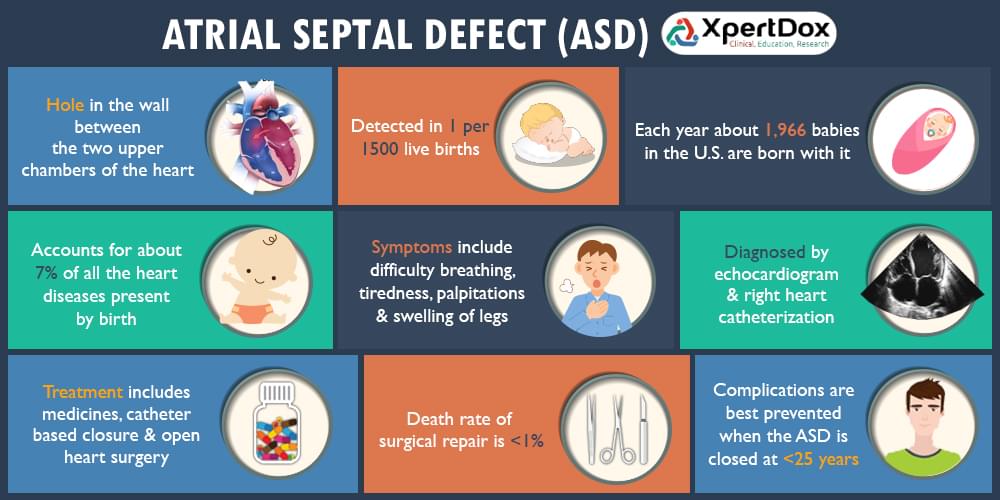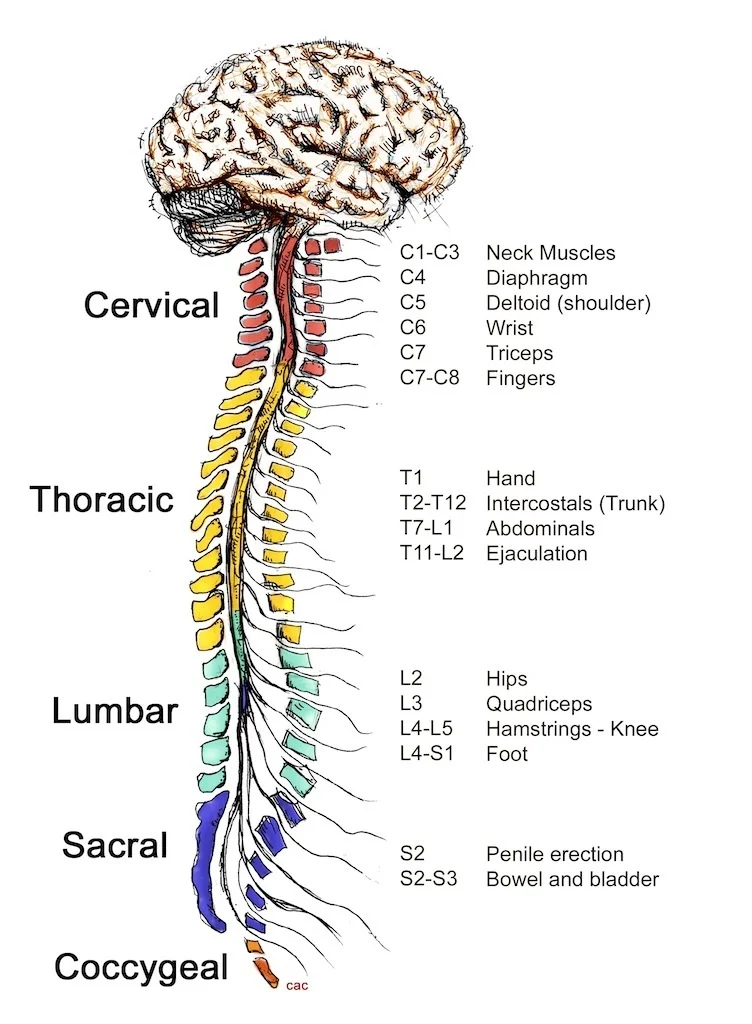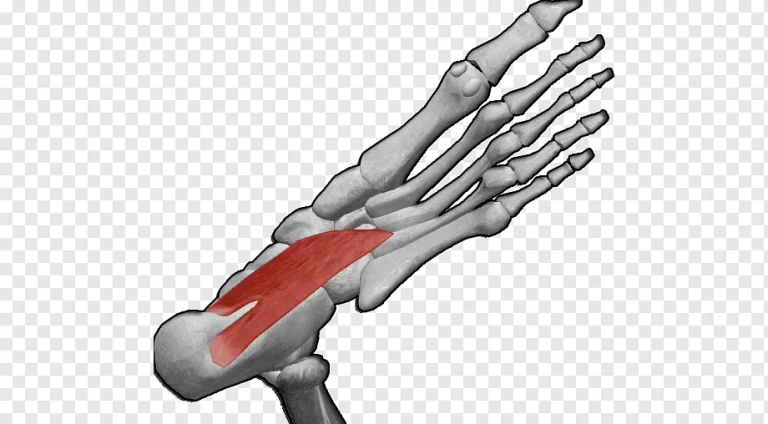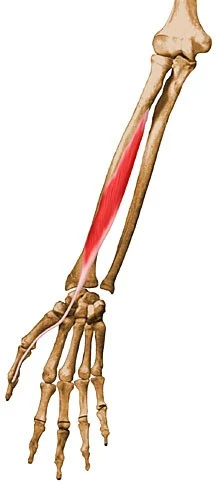ATRIAL SEPTAL DEFECT
OVERVIEW
An atrial septal defect (ASD) is a hole in the wall between the two upper chambers of your heart (atria). The condition is present at birth (congenital).
Small defects may never cause a problem and may be found incidentally. It’s also possible that small atrial septal defects may close on their own during infancy or early childhood.
Large and long-standing atrial septal defects can damage your heart and lungs. An adult who has had an undetected atrial septal defect for decades may have a shortened life span from heart failure or high blood pressure that affects the arteries in the lungs (pulmonary hypertension). Surgery may be necessary to repair atrial septal defects to prevent complications.
SYMPTOMS
Many babies born with atrial septal defects don’t have associated signs or symptoms. In adults, signs or symptoms may begin around age 30, but in some cases signs and symptoms may not occur until decades later.
Atrial septal defect signs and symptoms may include:
Shortness of breath, especially when exercising
Fatigue
Swelling of legs, feet or abdomen
Heart palpitations or skipped beats
Stroke
Heart murmur, a whooshing sound that can be heard through a stethoscope
Shortness of breath
Tiring easily, especially after activity
Swelling of legs, feet or abdomen
Heart palpitations or skipped beats
These could be signs or symptoms of heart failure or another complication of congenital heart disease.
CAUSES
How the heart normally works
The heart is divided into four hollow chambers, two on the right and two on the left. To pump blood throughout the body, the heart uses its left and right sides for different tasks.
The right side of the heart moves blood to the lungs through vessels called pulmonary arteries. In the lungs, blood picks up oxygen then returns to the heart’s left side through the pulmonary veins. The left side of the heart then pumps the blood through the aorta and out to the rest of the body.
DEVELOPMENT OF HEART DEFECT
Doctors know that heart defects present at birth (congenital) arise from errors early in the heart’s development, but there’s often no clear cause. Genetics and environmental factors may play a role.
ATRIAL SEPTUM DEFECT
The heart is divided into four hollow chambers, two on the right and two on the left. To pump blood throughout the body, the heart uses its left and right sides for different tasks.
The right side of the heart moves blood to the lungs through vessels called pulmonary arteries. In the lungs, blood picks up oxygen then returns to the heart’s left side through the pulmonary veins. The left side of the heart then pumps the blood through the aorta and out to the rest of the body.
DEELOPMENT OF ASD
Doctors know that heart defects present at birth (congenital) arise from errors early in the heart’s development, but there’s often no clear cause. Genetics and environmental factors may play a role.
HEART WORKS WITH ASD
An atrial septal defect (ASD) allows freshly oxygenated blood to flow from the left upper chamber of the heart (left atrium) into the right upper chamber of the heart (right atrium). There, it mixes with deoxygenated blood and is pumped to the lungs, even though it’s already refreshed with oxygen.
If the atrial septal defect is large, this extra blood volume can overfill the lungs and overwork the right side of the heart. If not treated, the right side of the heart eventually enlarges and weakens. If this process continues, the blood pressure in your lungs may increase as well, leading to pulmonary hypertension.
TYPES OF ASD
SECUNDUM– This is the most common type of ASD, and occurs in the middle of the wall between the atria (atrial septum).
PRIMUM– This defect occurs in the lower part of the atrial septum, and may occur with other congenital heart problems.
SINUS VENOSUS- This rare defect usually occurs in the upper part of the atrial septum.
CORONARY SINUS- In this rare defect, part of the wall between the coronary sinus — which is part of the vein system of the heart — and the left atrium is missing.
RISK FACTORS
It’s not known why atrial septal defects occur, but congenital heart defects appear to run in families and sometimes occur with other genetic problems, such as Down syndrome. If you have a heart defect, or you have a child with a heart defect, a genetic counselor can estimate the odds that any future children will have one.
Some conditions that you have or that occur during pregnancy may increase your risk of having a baby with a heart defect, including:
- RUBELLA INFECTION – bcoming infected with rubella (German measles) during the first few months of your pregnancy can increase the risk of fetal heart defects.
- Drug, tobacco or alcohol use, or exposure to certain substances. Use of certain medications, tobacco, alcohol or drugs, such as cocaine, during pregnancy can harm the developing fetus.
- Diabetes or lupus. If you have diabetes or lupus, you may be more likely to have a baby with a heart defect.
- Obesity. Being extremely overweight (obese) may play a role in increasing the risk of having a baby with a birth defect.
- Phenylketonuria (PKU). If you have PKU and aren’t following your PKU meal plan, you may be more likely to have a baby with a heart defect.
- COMPLICATIONS
A small atrial septal defect may never cause any problems. Small atrial septal defects often close during infancy.
Larger defects can cause serious problems, including:
- Right-sided heart failure
- Heart rhythm abnormalities (arrhythmias)
- Increased risk of a stroke
- Shortened life span
- Less common serious complications may include:
- Pulmonary hypertension. If a large atrial septal defect goes untreated, increased blood flow to your lungs increases the blood pressure in the lung arteries (pulmonary hypertension).
Eisenmenger syndrome. Pulmonary hypertension can cause permanent lung damage. This complication, called Eisenmenger syndrome, usually develops over many years and occurs uncommonly in people with large atrial septal defects.
Treatment can prevent or help manage many of these complications.
ATRIAL SEPTAL DEFECT AND PREGNANCY
Most women with an atrial septal defect can tolerate pregnancy without any problems. However, having a larger defect or having complications such as heart failure, arrhythmias or pulmonary hypertension can increase your risk of complications during pregnancy. Doctors strongly advise women with Eisenmenger syndrome not to become pregnant because it can endanger their lives.
The risk of congenital heart disease is higher for children of parents with congenital heart disease, whether in the father or the mother. Anyone with a congenital heart defect, repaired or not, who is considering starting a family should carefully discuss it beforehand with a doctor. Some medications may need to be stopped or adjusted before you become pregnant because they can cause serious problems for a developing fetus.
PREVENTION
In most cases, atrial septal defects can’t be prevented. If you’re planning to become pregnant, schedule a preconception visit with your health care provider. This visit should include:
Getting tested for immunity to rubella. If you’re not immune, ask your doctor about getting vaccinated.
Going over your current health conditions and medications. You’ll need to carefully monitor certain health problems during pregnancy. Doctor may also recommend adjusting or stopping certain medications before you become pregnant.
Reviewing your family medical history. If you have a family history of heart defects or other genetic disorders, consider talking with a genetic counselor to determine what the risk might be before getting pregnant.










One Comment